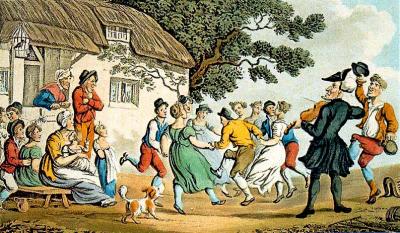- Historical Dance
- Jazz Age Social Dancing ("The Modern Dances")
- Ragtime Dance - the One Step
- Regency Dance
- "Mr Nelson's System of Simplified Regency Dance"
- An Analysis of Country Dancing - 1808
- Cotillions and Country Dances 1792
- Elements of the Art of Dancing - 1822
- The Complete System of English Country Dancing - 1815
- The Scholar's Companion - Cotillions and Country Dances - 1796
- Thos Wilson's Quadrille Instructor - Ca 1816
- Thos. Wilson's Description of Regency Waltzing - 1816
- Treasures of Terpsichore - 1816
- Victorian Dance
6. Music Choice and Choreography
The modern English Country dancer expects that for every dance there is a particular tune, and for every dance tune there is a particular dance - and each has, providentially, the same name. I wish to dance Auretti's Dutch Skipper, and by cracky, here's the right music for it, cause it's called "Auretti's Dutch Skipper".
Historically, such a match could happen if a dancing master wanted to cash in on the success of a popular hit tune by slapping together a suitable set of figures and saying "Hey, you've been humming it and singing it, now you can dance to it!".
There are also occasions when a dance master/author provided musical notation to match a specific dance choreography, though this seems to not be the norm by the Regency period.
The match could also be the result of a modern dance teacher grafting two pieces together to make a consistent whole, when such a relationship did not exist back in the day.
 In the Regency era it was customary for people to stand up for a dance not knowing anything more than that it was a Country Dance. The particular tune and dance may or may not have been arranged in advance by the head couple (most particularly the head lady), the band leader and the Master of Ceremonies.
In the Regency era it was customary for people to stand up for a dance not knowing anything more than that it was a Country Dance. The particular tune and dance may or may not have been arranged in advance by the head couple (most particularly the head lady), the band leader and the Master of Ceremonies.
After a quick bit of negotiation, the band would strike up a suitable tune and the head couple would cascade down the set, guiding the other couples through as they went. The exact tune did not have to be the same every time the dance was danced, it simply had to have the right structure.
This isn't as dangerous as it may sound. If you match the Country Dance choreographies of the later 18th and early 19th Century with the tunes of the same period, most can be made to more or less line up. Some line up better than others, but the ridged symmetry and universal structure of fours in both figures and music helps.
Listen to any 2-4 or 4-4 country dance tune of the period and, in your head, match "step-step, step-step, step-step, flourish (Pas Jette Assemblé)" to the music. You should hear it quite distinctly. If you don't, check it carefully. It may not be a Regency era Country Dance.
So, if you happen to open one of the historical dance books I have provided on this website, or another you have found elsewhere, and can't find a piece of music with the same name, don't stew about it. Just start playing tunes from your favorite CDs and try walking the patterns (with steps) until you find a congenial match.
You will also probably notice that original choreographies, while usually quite simple can often be a bit cryptic and leave room for alternative interpretations.
Consider if you will a randomly selected dance: "The New Pompe Room". The choreography seems pretty straight forward, but is it slow and stately, or is it fast and frenetic?
Is it in 4/4, 2/4, 6/8 or 3/4 time?
How would you like it to be? Any congenial combination of period music and dance choreography is, in the absence of additional specific evidence, as correct as any other. The dancers of the time were merrily mixing and matching, so there is no reason you shouldn't do the same.
Cast off two couples
Up again
Hands half round at top
Back again
Lead down the middle
Up again and cast off one couple
Right and left at top
